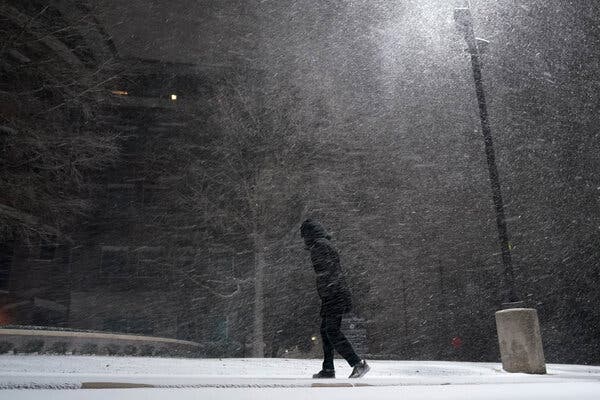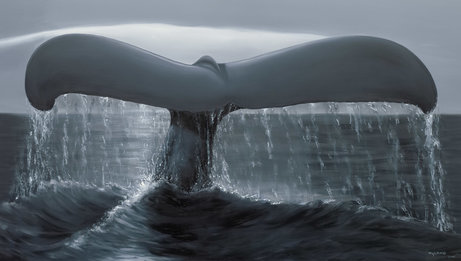
The polar vortex is descending on the midsection of the United States, bringing bitterly cold Arctic air and causing temperatures to plunge rapidly in many areas. The deep freeze will be accompanied by a major snowstorm that is expected to cause travel chaos.
The vortex is a large rotating expanse of cold air that generally circles the Arctic, but occasionally shifts south from the pole. Vortex-related cold snaps occur regularly in the United States. One of the most damaging occurred in February 2021, when the frigid air reached deep into Texas, resulting in temperatures that were as much as 40 degrees Fahrenheit below normal.
That freeze led to at least 250 deaths and caused extensive damage to the state’s power infrastructure.
As global emissions of heat-trapping carbon dioxide continue, the Arctic is warming nearly four times faster than other parts of the planet, according to the latest analysis, and the region’s sea-ice coverage is shrinking. So when the vortex meanders southward, two basic questions arise. What role, if any, does climate change play? And will extreme freezes increase as warming continues?
The short answer: Scientists aren’t sure, yet. There are clues, but still more to learn.
“I wish I had a clear answer,” said Steve Vavrus, a climate scientist at the University of Wisconsin. With Jennifer Francis, now at the Woodwell Climate Research Center in Massachusetts, Dr. Vavrus wrote a seminal 2012 paper that presented the idea that Arctic warming was affecting the polar vortex. “Unfortunately the state of things is still ambiguous,” he said.

What is the polar vortex, exactly?
The vortex is a mass of high-altitude, rotating air that, as the term suggests, occurs over the North Pole region. (There are actually two vortexes, one in the Arctic, the other in the Antarctic, but only the northern one affects weather in the Northern Hemisphere.)
The vortex strengthens and becomes much colder in winter, because with the Northern Hemisphere tilted away from the Sun at that time of year, little or no sunlight reaches the Arctic to warm it up.
If you were looking down at the North Pole, the air would look like it was rotating counterclockwise. Some scientists have compared it to a spinning top. The vortex is encircled by the polar jet stream, a band of winds that blows from west to east around the planet.
What happens during a deep freeze?
In normal conditions, the vortex is stable and confined to the Arctic. But just as a spinning top can start to wobble and drift if it bumps into something, the vortex can be disrupted. It is accompanied by changes to the jet stream, which develops a wavy, snakelike pattern as it circles the globe.
Sometimes the vortex splits into several fragments that move southward. Sometimes, as appears to be the case this week, it becomes stretched, like a rubber band. Either way, the disruption can have several major effects.
Temperatures in the atmosphere over the Arctic can rise, sometimes dramatically. At the same time, the frigid Arctic air moves southward.
If the movement is rapid enough, temperatures in the areas exposed to the mass of cold air can fall by tens of degrees within hours, and can stay extremely low for days or even weeks until the vortex becomes stable again in the North Pole region.
How does the vortex get disrupted?
For climate scientists, this is the crux of the debate.
Some scientists say Arctic warming is causing disruptions in the vortex, through the changes in the polar jet stream. Others say that modeling suggests naturally variable factors are driving disruptions instead and that an increase in vortex disruptions that occurred previously — including a noticeable uptick in the 2000s — has not continued.
Judah Cohen, a climate scientist at Atmospheric and Environmental Research, a weather-risk assessment firm in Lexington, Mass., is an author of a paper this year that linked the 2021 Texas freeze to Arctic warming. He sees the same thing happening now.
The basic idea, he said, is that the warmer conditions create larger and more energetic atmospheric waves that make the jet stream wavier, with greater peaks and troughs. That affects the polar vortex circulation.
To use the spinning top analogy, “it’s like if it started banging into things,” he said. “It loses its nice circular shape and in this case becomes more stretched out.” One lobe stretches down into Canada and the United States, bringing an outbreak of cold weather.
Dr. Cohen said he’s been studying the subject since 2005, and is more confident than ever about the link to changes in the Arctic. “The evidence is only growing,” he said.
Other scientists are not as certain. In a brief paper in the journal Nature Climate Change in 2020, two researchers at the University of Exeter in England wrote that, although Arctic warming and sea-ice loss were continuing, the short-term trends in cold extremes, jet-stream waviness and other climate-related measurements in the 1990s and 2000s “have not continued over the past decade,” weakening the argument that rising temperatures in the Arctic were the culprit.
Some experts suggest that rather than warming, other naturally variable elements of the earth’s climate may be affecting the vortex. Among these, said Ted Shepherd, a climate scientist at the University of Reading in England, are sea-surface temperatures in the tropical Pacific Ocean, which can drive changes to air masses in the Arctic that disrupt the jet stream and vortex.
Will this debate get resolved?
Scientists say that questions over what role Arctic warming may play in extreme cold snaps is an example of the kind of healthy climate-change debates that occur now. It’s not about whether climate change is real — that question has been answered — but what kinds of effects it has, how severe they are and whether they will worsen as warming continues.
Most scientists view this debate as an important one that is still underway. Dr. Vavrus said that some aspects “are on pretty solid physical footing.” Among these, he said, is the idea that Arctic warming, by reducing the temperature difference between the Arctic and the tropics, has weakened the jet stream winds. But other aspects, including whether and where warming is making the jet stream wavier, “are the things that we’ve really been wrestling with and remain uncertain,” he said.
“In the early days there was a lot of black and white thinking, including among people like myself, on this question,” Dr. Vavrus added. “As more and more evidence has come in, it’s clear that there are many shades of gray.”
